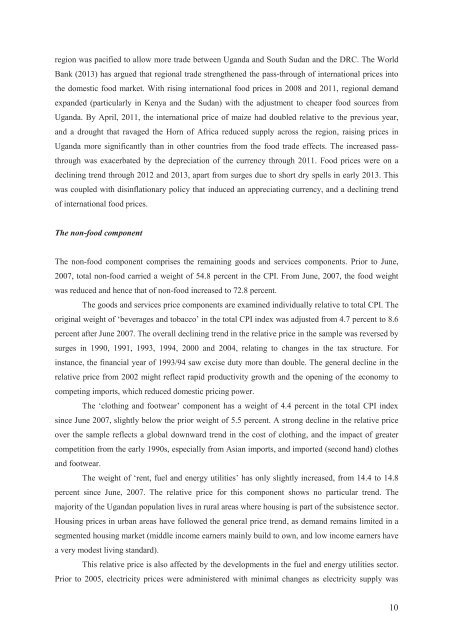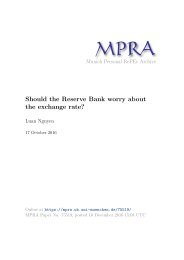You also want an ePaper? Increase the reach of your titles
YUMPU automatically turns print PDFs into web optimized ePapers that Google loves.
egion was pacified to allow more trade between Uganda and South Sudan and the DRC. The WorldBank (2013) has argued that regional trade strengthened the pass-through of international prices intothe domestic food market. With rising international food prices in 2008 and 2011, regional demandexpanded (particularly in Kenya and the Sudan) with the adjustment to cheaper food sources fromUganda. By April, 2011, the international price of maize had doubled relative to the previous year,and a drought that ravaged the Horn of Africa reduced supply across the region, raising prices inUganda more significantly than in other countries from the food trade effects. The increased passthroughwas exacerbated by the depreciation of the currency through 2011. Food prices were on adeclining trend through 2012 and 2013, apart from surges due to short dry spells in early 2013. Thiswas coupled with disinflationary policy that induced an appreciating currency, and a declining trendof international food prices.The non-food componentThe non-food component comprises the remaining goods and services components. Prior to June,2007, total non-food carried a weight of 54.8 percent in the CPI. From June, 2007, the food weightwas reduced and hence that of non-food increased to 72.8 percent.The goods and services price components are examined individually relative to total CPI. Theoriginal weight of ‘beverages and tobacco’ in the total CPI index was adjusted from 4.7 percent to 8.6percent after June 2007. The overall declining trend in the relative price in the sample was reversed bysurges in 1990, 1991, 1993, 1994, 2000 and 2004, relating to changes in the tax structure. Forinstance, the financial year of 1993/94 saw excise duty more than double. The general decline in therelative price from 2002 might reflect rapid productivity growth and the opening of the economy tocompeting imports, which reduced domestic pricing power.The ‘clothing and footwear’ component has a weight of 4.4 percent in the total CPI indexsince June 2007, slightly below the prior weight of 5.5 percent. A strong decline in the relative priceover the sample reflects a global downward trend in the cost of clothing, and the impact of greatercompetition from the early 1990s, especially from Asian imports, and imported (second hand) clothesand footwear.The weight of ‘rent, fuel and energy utilities’ has only slightly increased, from 14.4 to 14.8percent since June, 2007. The relative price for this component shows no particular trend. Themajority of the Ugandan population lives in rural areas where housing is part of the subsistence sector.Housing prices in urban areas have followed the general price trend, as demand remains limited in asegmented housing market (middle income earners mainly build to own, and low income earners havea very modest living standard).This relative price is also affected by the developments in the fuel and energy utilities sector.Prior to 2005, electricity prices were administered with minimal changes as electricity supply was10





